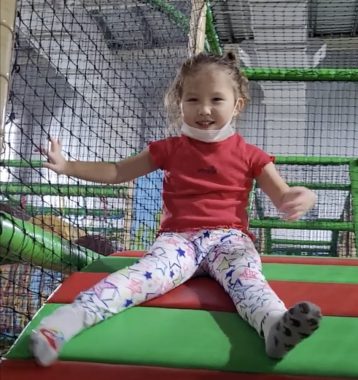Adaptive Clothing for Kids Creates Functionality, Not Stigma
Columnist Richard E. Poulin III shares his daughter's wardrobe evolution

When the holidays approach, we scour department stores to find an outfit our 4-year-old daughter, Rylae-Ann, can wear so that she looks great in our seasonal family photos. She accommodates us by wearing all of the clothes we want her to, but we struggle during bathroom breaks and at the end of the day to take off the cute clothing.
We hadn’t considered that our daughter needs special clothing to manage the symptoms of aromatic l-amino acid decarboxylase (AADC) deficiency.
Adaptive clothing
When we realized Rylae-Ann needed something more accommodating, I wasn’t sure what to search for. However, my online queries for “inclusive clothing” and “adaptive clothing” provided more than enough search results.
The clothing was fashionable and seemed pretty standard. It reminded me of when Rylae-Ann was younger and we always kept her in a mesh onesie to help with her temperature instability. We have since moved slightly away from functionality and started caring more about design.
A balance of design and function
Dressing is an essential, lifelong skill. If we always do it for her, we deny her the opportunity to learn, and we teach her helplessness. We spend money for her to attend occupational therapy, which incorporates similar movements. Not taking the time to let her dress is like skipping class.
The more fashionable the clothing, the higher the price. We were strategic in what we bought since she’s still growing. Like the standard stores, the specialty shops online also had sales and discounts.
Following are some of the features that stood out to us.
Sensory considerations
We are working on our daughter’s sensory processing issues. I didn’t consider how clothing could play a role in supporting her. Soothing textures and touch can cause the release of both serotonin and dopamine, which AADC-deficient children lack.
While sleeping, our daughter benefited from a weighted blanket or an arm across her chest. The weight or pressure can help to alleviate anxiety. Inclusive clothing ranged in thickness all the way up to full compression. Compression clothing is not easy to put on, but it was ideal for events when anxiety could be heightened.
Research suggests that pressure or firm tactile sensations can provide a calming feeling. It can also help to counter hypotonia symptoms. Like soothing textures, sensory compression and deep pressure can increase serotonin and dopamine. It can also slow involuntary functions such as heart rate, blood pressure, and the production of the stress hormone cortisol.

Rylae-Ann wears compression pants during a sensory integration therapy session. (Photo by Richard E. Poulin III)
No seams, buttons, or tags
Finding clothing without seams, buttons, or tags makes it much more comfortable. Rylae-Ann is becoming more active, but she was often sitting or lying down before she had gene therapy. It would be highly uncomfortable if she had something pressing into or otherwise irritating her skin.

Rylae-Ann wears clothing that has no seams and tags, and has a smooth feel on her skin to reduce anxiety. (Photo by Richard E. Poulin III)
Magnets and Velcro
During occupational therapy classes, Rylae-Ann works on fine motor skills by using buttons and zippers, so keeping these things on her clothing initially seemed important. I want her to be independent, but if I remain fixated on her ability to use a button, she may not achieve complete independence.
Therefore, clothing with concealed magnets or Velcro allows her to easily open and close it. From the outside, it is barely noticeable. Testing it, we have not had any wardrobe malfunctions, but cheaply designed products could accidentally cause exposure issues.
Added traction or protection
Traction and protection on clothing were our favorite features. Our daughter began falling more as she learned to walk. This gave her more confidence, even if she wasn’t 100% successful. Socks with grips or pants with protection at the knees helped us step back and allow her to take risks.

Rylae-Ann wears socks with added traction to improve her stability. (Photo by Richard E. Poulin III)
Loops and large openings
The final feature is so simple that all clothing should have it. Adaptive clothing included loops, known as motor skill support, so our daughter could easily pull it up. Motor skill supports are available on undergarments, pants, and shoes.
Many shirts came with Velcro at the collar to create a larger opening. These could be used for caregivers to easily slip on shirts or as training for children to dress independently.

Rylae-Ann wears shorts with loops to support motor skills. (Photo by Richard E. Poulin III)
Note: AADC News is strictly a news and information website about the disease. It does not provide medical advice, diagnosis, or treatment. This content is not intended to be a substitute for professional medical advice, diagnosis, or treatment. Always seek the advice of your physician or other qualified health provider with any questions you may have regarding a medical condition. Never disregard professional medical advice or delay in seeking it because of something you have read on this website. The opinions expressed in this column are not those of AADC News or its parent company, Bionews, and are intended to spark discussion about issues pertaining to aromatic l-amino acid decarboxylase deficiency.








Leave a comment
Fill in the required fields to post. Your email address will not be published.